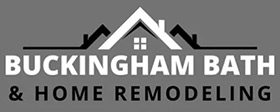Why Screwing Down the Subfloor After Demo Matters More Than You Think
You know that satisfying moment when an old floor comes up and you can finally see the bare bones of your home? It’s the first real sign of progress after demolition. But beneath that excitement lies one of the most overlooked—and most important—steps in any quality remodel: screwing down the subfloor before rebuilding.
At first glance, it might seem like a minor detail. After all, the subfloor is something you’ll never actually see. But if you’ve ever lived in a home where the floor creaked, bounced, or felt uneven underfoot, you’ve already experienced what happens when this step is skipped.
Let’s dig into why this matters, how it protects your investment, and what a professional remodeler (like Buckingham Bath & Home Remodeling) does to make sure your floors feel solid for decades.
🧱 The Subfloor: The Unsung Hero of Your Home
Think of the subfloor as the backbone of your flooring system. It’s the flat, structural layer—usually plywood or oriented strand board (OSB)—that sits directly on top of your floor joists. Everything else in your finished space depends on it: hardwood, tile, cabinetry, and even walls.
Over time, nails that hold older subfloors in place can loosen. The house settles, joists expand and contract, and those tiny movements add up. When you remove the old flooring during demo, the subfloor is suddenly exposed—and that’s your golden opportunity to make it stronger and quieter than ever.
🔩 Why Screws Beat Nails—Every Time
Here’s where craftsmanship meets physics.
Most older homes were built using nails to secure the subfloor. It was faster and cheaper—but nails can work loose with seasonal changes, humidity, and regular foot traffic. Screws, on the other hand, create a mechanical bond. They bite tightly into both the subfloor and joist, holding tension that resists movement.
Benefits of screwing down your subfloor after demo:
-
Eliminates squeaks and pops. Each screw locks the panel down firmly, reducing movement and friction between materials.
-
Levels out uneven areas. Screws can draw warped boards tighter to joists, creating a flatter foundation for your finished floor.
-
Prevents long-term shifting. Screws resist backing out, so your floor stays solid even as humidity changes over the years.
-
Increases structural stability. It tightens the entire floor system, which can even help cabinetry and tile installations last longer without cracking or separation.
This is one of those steps that homeowners rarely see—but always feel in the finished product.
⚒️ The Right Way to Do It
At Buckingham Bath & Home Remodeling, we treat every subfloor inspection as a quality checkpoint, not a quick task. After demolition, our crews:
-
Inspect the subfloor and joists for damage, water stains, or soft spots.
-
Re-secure every seam and joint using construction screws—not drywall or deck screws, which can shear under pressure.
-
Add adhesive where appropriate for additional hold and squeak prevention.
-
Replace damaged panels before new underlayment or finish materials go down.
That attention to detail may take extra time, but it ensures the next phase—tile, hardwood, or luxury vinyl—is being installed on a foundation that won’t flex, crack, or shift later.
🧠 Long-Term Payoff: Quiet, Solid, and Built to Last
A properly screwed-down subfloor does more than just silence creaks—it protects your investment.
-
Tile won’t crack. Movement in the subfloor is one of the biggest culprits behind cracked grout or tile.
-
Cabinets stay level. A solid, flat subfloor ensures cabinetry sits evenly and doesn’t settle unevenly over time.
-
Hardwood and vinyl wear evenly. You’ll avoid soft spots or “spongy” areas that can appear in poorly fastened floors.
-
The home feels premium. A silent, sturdy floor is one of those invisible markers of quality that every discerning homeowner notices subconsciously.
💬 Conclusion: The Hidden Step That Defines Quality
In remodeling, the best work often happens where you can’t see it. Screwing down your subfloor after demo may not make for flashy photos—but it’s one of the quiet investments that separates a lasting remodel from one that just looks good on day one.
When your floors feel solid, quiet, and seamless, that’s craftsmanship you can live on—literally.
If you’re planning a kitchen or bath remodel and want a team that prioritizes every hidden layer of quality, reach out to Buckingham Bath & Home Remodeling.
Question for you:
When you walk across your current floors, do they feel solid and silent—or can you hear every step? That simple sound could tell you everything about how your home was built.
